


































The Washington Post
For Christmas in 2019, architect Jennifer Lee gave her mom, Jisoo Lee, a book titled “A House For My Mother.” It’s a compilation of residential structures that wellknown architects, including Charles Gwathmey and Robert Venturi, built for their loved ones.
“There’s a grand tradition of young architects building houses for their parents,” Jennifer says. “My mother supported me unconditionally through architecture school, so building a house for her someday was always a dream in the back of my mind.”
At the time, Jisoo and her husband, Chong Doo Lee, weren’t looking to leave their home in Potomac. “I was comfortable here,” says Jisoo. “I love that it’s modest. If anyone has a small house in this area, they rip it down and put up a big house or a McMansion.”
The empty nesters had lived in the same house since 1998 and had many memories of family celebrations with their two daughters (Jennifer’s sister Michele Torrecilla lives nearby with her family). But the house, which consisted of a one-room stone cabin with a two-story addition, wasn’t feasible as a long-term solution as they aged.
“As they were getting older, we were anticipating the next logical steps, like eliminating stairs and making the house easier to maintain,” Jennifer says.
With that in mind, she started planning a full-scale renovation of the house with Pablo Castro, her husband
She designed a dream house for her mother
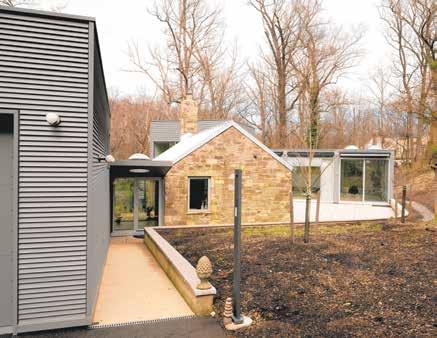
and partner in the New York Citybased firm Obra Architects. “The main purpose for the project was to create a place worthy of them spending their last years,” Jennifer says. “My mother was cognizant of the fact that she was in her late 70s, and she wanted to get this done so she would have some years to enjoy the house. That was back when we originally began — before COVID.”
Her parents moved into her sister’s basement while construction got underway. But on the night of Chong Doo’s birthday in May 2020, just as demolition began, Jisoo became sick with COVID. The next day she was admitted to the hospital, where she was intubated and remained in the intensive care unit for 56 days. “On
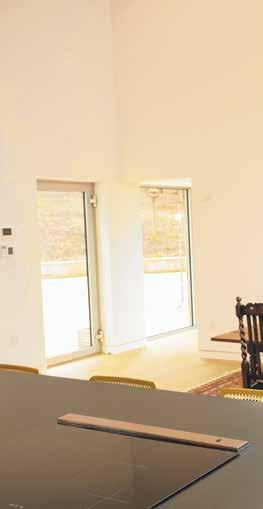
renovation became a hopeful rallying point for the entire family.
several occasions we were asked by medical staff if we wanted to give up, but we were not prepared to even contemplate that yet,” says Jennifer. Jisoo moved to two other hospital facilities before eventually being weaned off the ventilator.
Jisoo finally went home on Sept. 11, 2020, but she was still unable to stand up or walk on her own. She and Chong Doo moved from Michele’s basement into her bedroom so Jisoo could convalesce as the renovation project got underway at their house. “My sister basically nursed my mother back to health with her 24-hour attention,” says Jennifer. Soon both Jennifer and Michele realized that talking about the house was helping to buoy their mom’s spirit on the darkest days. The
“The start of construction on this house and the possibility of her recovery, which at that time seemed remote, somehow became intertwined,” says Jennifer. “We all felt that hope and held onto it. At the same time, there was this ever-present uncertainty around whether or not she would make it to the completion of the house. That became our biggest motivator to get it done.”
And so, while Jisoo’s recovery was underway, the renovation moved forward — at least as best as it could in the midst of a global supply chain meltdown. “Building during the pandemic was problematic,” says Jennifer. “We experienced all the delays and overpricing of construction materials, and labor was scarce.”
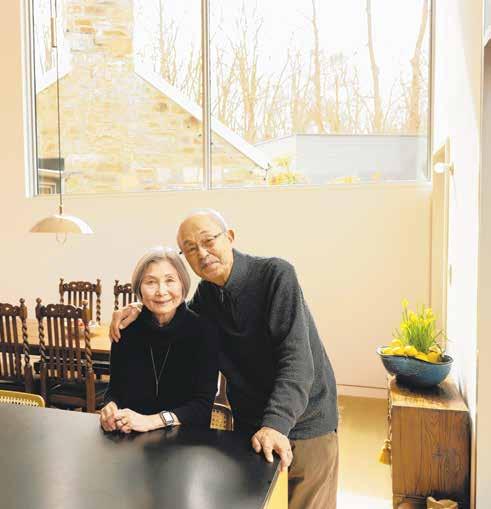
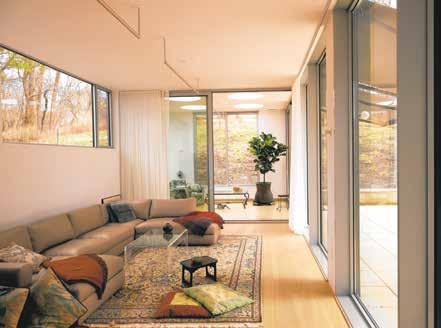
Eventually they proceeded with Think Make Build as the contractor and Pillars Construction, who installed the home’s exterior cladding.
The architects’ plan was to restore the original stone hunting cabin and replace the two-story addition with a new single-level contemporary one, creating four zones: the main living area, a primary suite, guest quarters and a study for Chong Doo. “We wanted to preserve the cabin because the masonry would be hard to replicate today,” says Castro. “Plus, it’s a historic structure, so it has some real soul, which we didn’t want to lose.”
For the exterior of the addition, the architects chose an enamel-coated corrugated steel from Korea for its durability and the way its horizontal lines follow the landscape and evoke the overlapping siding of a more traditional house.
“The windows were the most obvious luxury the house had,” says Castro. “When you’re in the house you feel this incredible connection with the outside.” Nowhere is that connection more evident than the primary bedroom, which sits like a treehouse suspended by thin steel columns above the creek.
The large glass panels shower the interiors with natural daylight and afford sightlines that extend from the forest floor to the sky overhead. To allow those views to be the focus, the architects chose quiet finishes for the interiors. Wide-plank white oak floors lend a warm glow throughout and harmonize with the kitchen’s custom white oak cabinetry, which was designed by Milan-based Giacomo Moor, a friend of both Castro and Lee.
While the home’s interiors were designed with accessibility in mind, it’s not obvious to visitors. “My mom,
who was extremely fit before she got sick, didn’t want a house that looks like it’s for someone who’s unwell, but the provisions are in place,” says Jennifer.
Everything is on one level, and there are only a couple of steps in the home, allowing it to follow the lay of the land. Bathrooms are accessible, with widened doorways that can accommodate a wheelchair. And the primary bath has a curbless shower, but there are no grab bars on the walls — they can be added if needed in the future. Sustainability was also a consideration. The house features solar panels, radiant heat flooring and LED lights.
It took nearly three years, but by May 2023, the renovation was complete. Jisoo has settled into the house with Chong Doo and while she has come a long way in her recovery, she may never completely regain her pre-COVID energy. She can no longer travel long distances or participate in the yoga classes she once loved, though she’s getting stronger each day.
“Witnessing her recovery was inspiring to all of us because we got to see her fighting spirit in action,” says Castro.
In fact, while she was staying at Michele’s she threw out her walker the moment she could walk on her own. “We found it on the street curb of my sister’s house,” laughs Jennifer. “The same thing happened to the foot brace they gave her.”
These days Jisoo spends her days gazing out the windows at the wildlife and listening to the rhythms of the wind and stream. In fact, she’s become a bit of an amateur videographer: She loves to record the neighborhood deer coming out for dinner and the blue heron soaring through the trees. She sends those videos to her daughters with commentary.
“I love that I get to experience all the seasons in this house,” she says. “Since I got sick, I stay home all the time, but because I love it here so much, I don’t want to ever leave.”
The Washington Post
There’s no denying the transformative power of the right area rug in a room. A rug can add warmth, texture and visual interest to a space. It can also help zone a room, reduce noise and protect hardwood floors. Without something cozy underfoot, bare floors can feel cold and underdressed. But if you go shopping for a rug you might be floored — by wildly varying prices and the exhausting number of choices, especially online.
With that in mind, we asked a handful of interior designers and one rug pro to share their advice on how they navigate shopping for a rug that’s of good value. Whether you’re budgeting for a quick style refresh or more of an investment piece, here’s how to spend wisely.
• Consider materials
Every designer interviewed for this story said wool is the best material for an area rug anywhere in the house. With the exception of silk, wool tends to be more expensive than other materials, but it also has a much longer life, so the added expense is worth it in their opinion. “It’s one of the oldest and most durable materials you can use for a rug,” says interior designer Krista Nye Nicholas of Cloth & Kind in Ann Arbor, Mich.
After wool, natural fibers, such as seagrass, and indoor-outdoor performance rugs made from polypropylene or polyethylene

terephthalate (commonly called PET) were all recommended by the designers, particularly for areas that might see a lot of wear, such as mudrooms or laundry rooms. Another option is to go with a wool blend. As a way of making some rugs more affordable, companies will blend wool with a semi-synthetic material such as viscose, which is a form of rayon that approximates the softness of
silk. “If budget is a concern and you do opt for something with viscose, then I would recommend the lowest percentage — for example, 80% wool and 20% viscose,” says interior designer Stacey Dobrovolny of 2 Navy Lane in Culpeper, Va.
• Know what’s in your budget
We broke retailers into three tiers to distinguish between inexpensive, moderately priced and what some
designers considered to be a worthwhile value for the expense. Because 8’ x 10’ is a common size many homeowners search for, we used that as the standard for pricing.
• Inexpensive ($200 to $500): There aren’t any real surprises for shoppers working with a modest budget. Dobrovolny likes online destinations such as Wayfair or Amazon for their wide selection, low prices and the fact that they deliver — a true godsend when you think of schlepping a rug around town. However, if you need to send it back, you may have to pay return shipping fees and a restocking charge, depending on the vendor. If you prefer to see the goods in person, she recommends browsing big-box stores HomeGoods, At Home and Homesense. “Home Depot, Lowe’s and Target are also good because it’s easy to take it back if you get it home and decide you don’t like it,” she says.
Mimi Meacham of Houstonbased Marian Louise Design favors both Ikea and Urban Outfitters for affordable, youthful styles. While it may be tempting to score an 8’ x 10’ rug for less than $200 (they do exist), she warns, “If you go below that price point, you’re really sacrificing quality and I don’t think it will last long or look great.”
• Moderately priced ($500 to $1,500): Once you go above $500, the field of choices expands exponentially. Nye Nicholas and Dobrovolny name-checked Revival, Lulu and Georgia, and Loloi for
(See RUGS 17)












Bathrooms are some of the most utilitarian rooms in our homes. But they can also be the most relaxing — scroll through luxury listings on Zillow and count how many times you read the word “spa.”
If you want to turn yours into a private oasis, however, there’s no simple answer to how much renovating it will cost you. Prices vary depending on where you live, whether you hire a designer, how much plumbing and electrical work is required, the types of finishes you want, and more. Every remodel is different.
This is why we asked three homeowners: How much did it cost to renovate your bathroom? These renovations, all completed within the last year, account for different budgets and locations. Here’s a breakdown of what they spent — and where they saved.
Total cost: $17,275.
Total time: Six months.
Location: Port Ludlow, Wash.
Completed: November 2023.
When Collene Funk bought her remote Washington state fixer-upper in 2014, the primary bathroom still
had metallic rainbow wallpaper and 1980s-style carpeting (yes, carpeting). She and her husband did the “bare minimum” to make the room usable — including replacing the too-low toilet and the carpet with tile flooring. “That was just a Band-Aid to make sure we could tolerate the bathroom while we did some renovations in the rest of the house,” Funk says.
Her main goal for the renovation was to gain more storage space in cabinets, keep the aesthetics consistent with the recently renovated living room and primary bedroom, and stay within budget. Funk’s husband, a retired contractor, constructed several parts of the project himself. She estimates that hiring someone else to do the work he did would have added a minimum of $6,000 to the total.
Even so, the budget was blown nearly from the start when they began re-tiling the shower and discovered rotted floorboards. This added to the timeline — “we rebuilt for four days before a single piece of tile was laid,” she says — and more than doubled the original $4,000 estimate for the tile contractor.
Another splurge was the vanity. Funk’s husband built it from raw mahogany and topped it with granite, for a total cost of about $3,400. Still, it was cheaper than the premade options they considered. One wrinkle:

The old vanity was only 31 inches tall (fairly standard in the 1980s), so they had to move outlet boxes to match the new, higher countertop.
After a mistake with the shower tile order (which would have added time and money to fix), the couple wound up buying an off-the-shelf, beige option from Home Depot.
Smaller fixtures such as towel bars, door handles and faucets came from Lowe’s; Funk went with a brushed nickel finish for all of them.
Budget breakdown:
Countertop: $2,704.
Shower tile labor: $8,200.
Tile and grout: $1,757.
Shower door: $1,500.

few things in the renovation that did not come from U.S. manufacturers, coming instead from Spain.
Faucets and sinks: $465.
Hardware: $270.
Towel bars: $365.
Vanity wood: $704.
Drywall and plywood: $360.
Other finishes: $455.
Mirrors: $200.
Light fixtures: $295.
Bathroom 2:
Total cost: $49,090.
Total time: Eight months.
Location: Richardson, Tex.
Completed: January 2024.
When Laurie Kline bought her home in a Dallas suburb 20 years ago, she hired a painter to cover the primary bathroom’s brown-swirled marble vanity. The paint “almost immediately started flaking,” she says. Ever since, she’d longed to renovate the whole room (complete with leopard-print wallpaper and saloon doors to the toilet). Finally, in April 2023, she decided it was time.
From the start, Kline says, she and her husband were surprised by how expensive the planned renovation was compared with a bid they’d gotten a decade prior. “We had 10-year-old money in mind, and it was definitely double that,” she says. That’s why the
couple took eight months to finish the remodel; doing it in phases allowed them to save up in between.
The couple also saved by sourcing materials themselves, rather than through a contractor. They found tile at wholesale flooring chain ProSource and matching all-black, squared fixtures such as faucets, handles and towel hangers online from Build With Ferguson. She also bought a mirror with a rear light at Home Depot.
The demolition took three days, including ripping out a space-hogging jetted tub and adding a larger shower. Tiling was the biggest expense at over $9,000, including materials and labor. Kline wanted to keep a wall of original glass bricks because they allow more light to come into the space, so she chose gray ceramic tile that she thought complemented that feature.
The vanity mirror that finally worked out was the fifth model ordered for the project — two were smashed on arrival, another was chipped after installation and yet another was the wrong style.
Kline did task her contractors with sourcing the cabinets and
(See BATHROOMS 12)


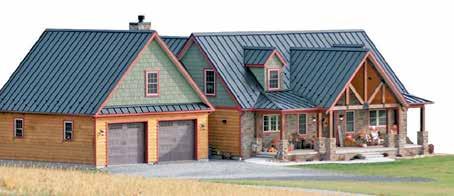




















$25 VISA GIFT CARD




Upon completion of appointment
$25 VISA GIFT CARD
Upon completion of appointment

LIFETIME NO-CLOG WARRANTY

15% OFF TOTAL SALE*
Does not include cost of materials
MADE ONSITE SPECIFICALLY FOR YOUR HOME
THE ONLY ONE-PIECE SEAMLESS DEBRIS SHEDDING GUTTER SYSTEM.
SCRATCHGUARD® PAINT FINISH
*Guaranteed not to clog for as long as you own your home, or we will clean your gutters for free

*All participants who attend an estimated 60-90-minute in-home product consultation will receive a $25 Visa gift card. Retail value is $25. O er sponsored by Leafguard Holdings Inc. Limit one per household. Company procures, sells, and installs seamless gutter protection. This o er is valid for homeowners over 18 years of age. If married or involved with a life partner, both cohabitating persons must attend and complete presentation together. Participants must have a photo ID and be legally able to enter into a contract. The following persons are not eligible for this o er: employees of Company or a liated companies or entities, their immediate family members, previous participants in a Company in-home consultation within the past 12 months and all current and former Company customers. Gift may not be extended, transferred, or substituted except that Company may substitute a gift of equal or greater value if it deems it necessary. Gift card will be mailed to the participant via rst class United States Mail within 10 days of receipt of the promotion form. Not valid in conjunction with any other promotion or discount of any kind. O er not sponsored and is subject to change without notice prior to reservation. O er not available in the states of CA, IN, PA and MI. Expires 4/30/24.








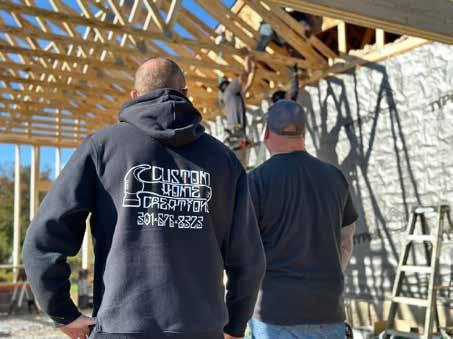



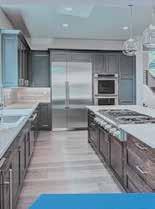
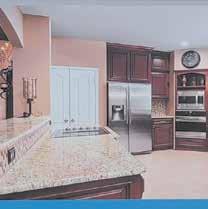

(Continued from 11)
countertops, since she wasn’t sure how much she’d need. The result is an L-shaped, double-sink vanity painted taupe, topped with quartz.
Though her contractor tried to talk her out of getting heated floors, she insisted on them and says the addition was well worth it, costing less than she expected. The entire project went relatively smoothly, Kline says, though her biggest takeaway was that she was grateful to have been able to work from home throughout it. “There’s always something,” she says, “and I wouldn’t want to come home at the end of the day and find out that the plumber had a question and left because there was nobody here to answer it.”
Budget breakdown:
Designer fee: $2,250.
Demolition: $1,594.
Shower: $1,788.
Tiling: $9,136.
Painting: $4,532.
Fixtures: $8,792.
Countertops: $4,645.
Cabinets: $5,742.
Heated flooring: $2,405.
Electrical: $3,089.
Plumbing: $5,117.
Total cost: $74,082.
Total time: 15 months.
Location: Arlington, Va.
Completed: June 2023.
Cheryl Conlin had an unusual goal for her bathroom renovation: to source as many materials manufactured in the United States as possible. “I wanted to highlight the beauty of American craftsmen,” she says. “I didn’t want, as I told my designer, that white marble bathroom that everyone has. … I don’t find beauty in that.” As such, several of the materials in the final product are bespoke.
Conlin had planned for years to renovate her condo’s only bathroom (which still wore its original 1980s style), so she’d saved enough to bring her specific vision to fruition — even when that meant paying over $1,000 for a custom tile delivery. “I was just really impressed and carried away by the beauty of it all,” she says. “It was a ‘sky’s the limit’ sort of thing.” Her original budget of $50,000 ballooned by $20,000.
She began working with a designer in March 2022, though the renovation didn’t begin for over a year, in part because of the unique materials.
Demolition posed a potential challenge, since contractors told Conlin to plan on her only bathroom being out of service for two to three weeks. Luckily, an out-of-town neighbor gave Conlin access to their unit.
The shower has tiles from California-based Heath Ceramics, a company founded by one of the first American female ceramicists. Builders also added a niche to hold bath products, plus a bench. The shower fixtures, some of the few items not sourced from the United States, arrived several months after they were ordered from a small factory in Italy. Conlin’s cabinets, made by a custom builder in Washington, Va., were designed in an L-shape to maximize drawer space. Conlin had a preferred cabinet shade in mind, but it took several samples, paint cards and a handcrafted wood stain to achieve the olive/khaki tone. To highlight the woodwork, she opted not to include handles or pulls.
Conlin’s old bathroom felt cramped due to bad design choices, such as a door that swung inward toward the toilet. She originally wanted to replace it with a spacesaving pocket door, but when

builders found the wall was too thin to accommodate one, she instead chose a sliding barn door with hidden hardware.
Despite a lengthy and pricey renovation, Conlin says she wouldn’t change anything about it. “It’s the nicest room in the house now,” she says. “It’s really exactly what I wanted.”
Budget breakdown:
Vanity: $7,952.
Labor: $8,900.
Plumbing fixtures: $5,213.
Vanity lighting and mirror: $1,878.
Toilet installation: $600.
Shower tile: $8,771.
Shower tile delivery: $1,238.
Floor tile: $685.
Shower doors: $3,500.
Countertops: $4,900.
Demolition: $10,450.
Plumbing: $4,500.
Electrical: $3,495.
Barn door: $4,000.
Project management: $4,500.
Design fee: $3,500.




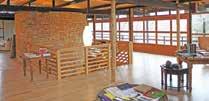





There’s no denying the transformative power of the right area rug in a room. A rug can add warmth, texture and visual interest to a space. It can also help zone a room, reduce noise and protect hardwood floors. Without something cozy underfoot, bare floors can feel cold and underdressed. But if you go shopping for a rug you might be floored — by wildly varying prices and the exhausting number of choices, especially online.
With that in mind, we asked a handful of interior designers and one rug pro to share their advice on how they navigate shopping for a rug that’s of good value. Whether you’re budgeting for a quick style refresh or more of an investment piece, here’s how to spend wisely.
• Consider materials
Every designer interviewed for this story said wool is the best material for an area rug anywhere in the house. With the exception of silk, wool tends to be more expensive than other materials, but it also has a much longer life, so the added expense is worth it in their opinion. “It’s one of the oldest and most durable materials you can use for a rug,” says interior designer Krista Nye Nicholas of Cloth & Kind in Ann Arbor, Mich.
After wool, natural fibers, such as seagrass, and indoor-outdoor performance rugs made from polypropylene or polyethylene
Designers say ‘unexpected red’ really works. Here’s how to use it.
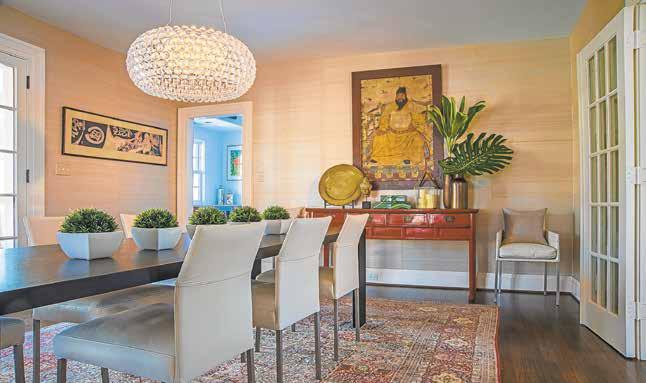
terephthalate (commonly called PET) were all recommended by the designers, particularly for areas that might see a lot of wear, such as mudrooms or laundry rooms. Another option is to go with a wool blend. As a way of making some rugs more affordable, companies will blend wool with a semi-synthetic material such as viscose, which is a form of rayon that approximates the softness of silk. “If budget is a concern and you do opt for something with viscose, then I would recommend the lowest percentage — for example, 80% wool and 20% viscose,” says interior designer Stacey Dobrovolny of 2
Navy Lane in Culpeper, Va.
• Know what’s in your budget
Because 8’ x 10’ is a common size many homeowners search for, we used that as the standard for pricing.
Inexpensive ($200 to $500): There aren’t any real surprises for shoppers working with a modest budget. Dobrovolny likes online destinations such as Wayfair or Amazon for their wide selection, low prices and the fact that they deliver — a true godsend when you think of schlepping a rug around town. However, if you need to send it back, you may have to pay return shipping fees and a restocking charge, depending on the vendor.
If you prefer to see the goods in person, she recommends browsing big-box stores HomeGoods, At Home and Homesense. “Home Depot, Lowe’s and Target are also good because it’s easy to take it back if you get it home and decide you don’t like it,” she says.
Mimi Meacham of Houstonbased Marian Louise Design favors both Ikea and Urban Outfitters for affordable, youthful styles. While it may be tempting to score an 8’ x 10’ rug for less than $200 (they do exist), she warns, “If you go below that price point, you’re really sacrificing quality and I don’t think it will last long or look great.”




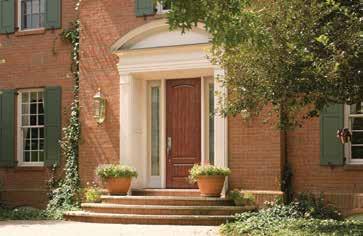

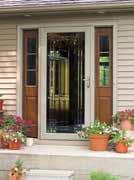



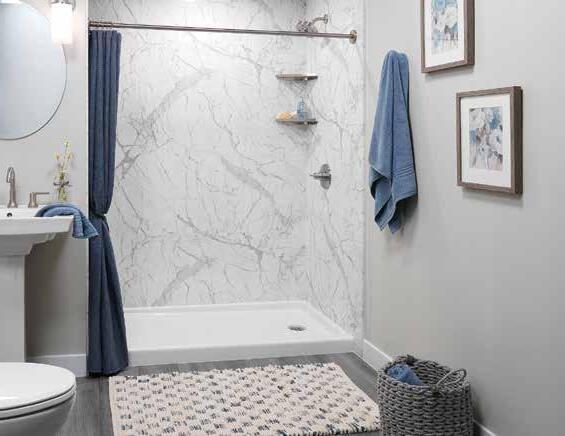
Contractors perform important work for millions of homeowners every day. Home improvement projects are complicated undertakings, and the experience of skilled contractors can ensure jobs are completed on time and within homeowners’ budgets.
Homeowners have undoubtedly heard horror stories from neighbors about projects that have gone awry. Projects can go sideways for a number of reasons, but a skilled contractor can help homeowners navigate such situations successfully. That underscores how important it can be to find the right professional for the job. The following are some tips homeowners can consider as they look to hire a contractor.
• Identify which professional you need. Some contractors are of the jack-of-all-trades variety, but many specialize in a particular line of work. It’s important that homeowners identify which type of contractor they should work with prior to starting a project. This requires homeowners to define the goal of the project (i.e., new wood floor installation), which can serve as a springboard into finding the right type of contractor.
• Prioritize building safety. Safety should be the utmost priority for homeowners and contractors alike. Prior to hiring a contractor, homeowners should identify any safety restrictions that might be enforced by local governments and take note of all the permits

Hiring a contractor? There are some things to know before you find one.
necessary to get a job done. Homeowners can then discuss those restrictions and permits as they interview contractors. Projects that do not adhere to code are illegal and can compromise homeowners’ ability to sell their homes in the future. So it’s vital to work with contractors who are familiar with local codes and aware of which permits are necessary to ensure a project can go forward.
• Insist on written estimates. Handshake agreements offer no protection to homeowners or contractors, so estimates indicating what will be done and how much the project will cost should be
provided. Homeowners should insist on receiving written estimates and interpret an unwillingness to provide one as a significant red flag.
• Know your rights. Laws vary by region, but in general homeowners have a right to a written contract and contractors are obligated to provide a copy of that contract signed by both parties. That contract must be provided prior to the start of the project. The contract should provide a detailed account of the work that will be done, as well as a timeline indicating important dates that components of the project will begin and be completed. The
contract also should detail materials and who is providing them. Details regarding payments, guarantees and warranties also should be cited.
• Do not pay in cash. Some contractors may suggest that the project will cost less if they’re paid in cash. However, home improvements should never be cash transactions. Cash does not indicate proof of payment, which can be problematic if a dispute arises.
Contractors help homeowners turn dream projects into reality. Homeowners can employ various strategies to ensure they find the right professional for their home improvement project.
(Continued from 11)
their range of options and on-trend designer collaborations. Rejuvenation also gets high marks for its affordable and well-made updates of traditional Turkish and Persian designs. “They do really good reproductions in great colorways,” Nye Nicholas says.
New Orleans designer Hattie Collins of Hattie Sparks Interiors likes both Annie Selke’s Dash & Albert line and Anthropologie’s whimsical designs for kids’ rooms. She’s also a fan of West Elm’s custom measure program for large seagrass rugs, though the company offers the service (which allows you to specify unusual dimensions) for select sisal, hemp and wool options, too. “While you can’t get it to within inches, you can get it within the foot,” she says. “It’s a good economical choice when you want something that feels more made-toorder.”
If new is not your thing, you can
find a trove of affordable wool vintage rugs in the mid-priced range, as well as newer reproductions on Etsy. Every designer we talked to loves the online marketplace for its dense selection and access to vendors from around the world. Without the benefit of assessing a rug’s quality in person, you’ll have to read vendor reviews and study the photos provided, which can give a good sense of the pile, colors and any areas of wear. Collins also pays close attention to customer reviews, especially the ones where buyers have posted photos of the rugs in their own homes.
Expensive, but good value ($1,500 to $4,000): While dropping $2,000 on a rug would be an absurd splurge for most people, in the world of fine rugs it’s considered a bargain. Here’s some context: “If you’re looking for an 8’ x 10’ that’s either an antique, something unique or a custom rug, you can easily go upwards of $10,000,” Nye Nicholas says.





















✓ First walk-in tub available with a customizable shower


Now you can nally have all of the soothing bene ts of a relaxing warm bath, or enjoy a convenient refreshing shower while seated or standing with Safe Step Walk-In Tub’s FREE Shower Package!
✓ Fixed rainfall shower head is adjustable for your height and pivots to o er a seated shower option

✓ High-quality tub complete with a comprehensive lifetime warranty on the entire tub
✓ Top-of-the-line installation and service, all included at one low, a ordable price
Now you can have the best of both worlds–there isn’t a better, more a ordable walk-in tub!


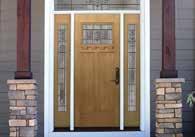




At May's Heating &Air,your home comfor tisour highest priority. That’swhy we supply dependable HVAC equipment and excellent work in Frederick. Our technicians are skilled in acomplete range of ser vices, so you can have confidence in your results. They’ll give the help you are seeking, whether it’sadding anew HVAC system or repairing and maintaining your existing equipment. We’re ready to help with all of your needs, so get in touch with us to get an appointment today!






